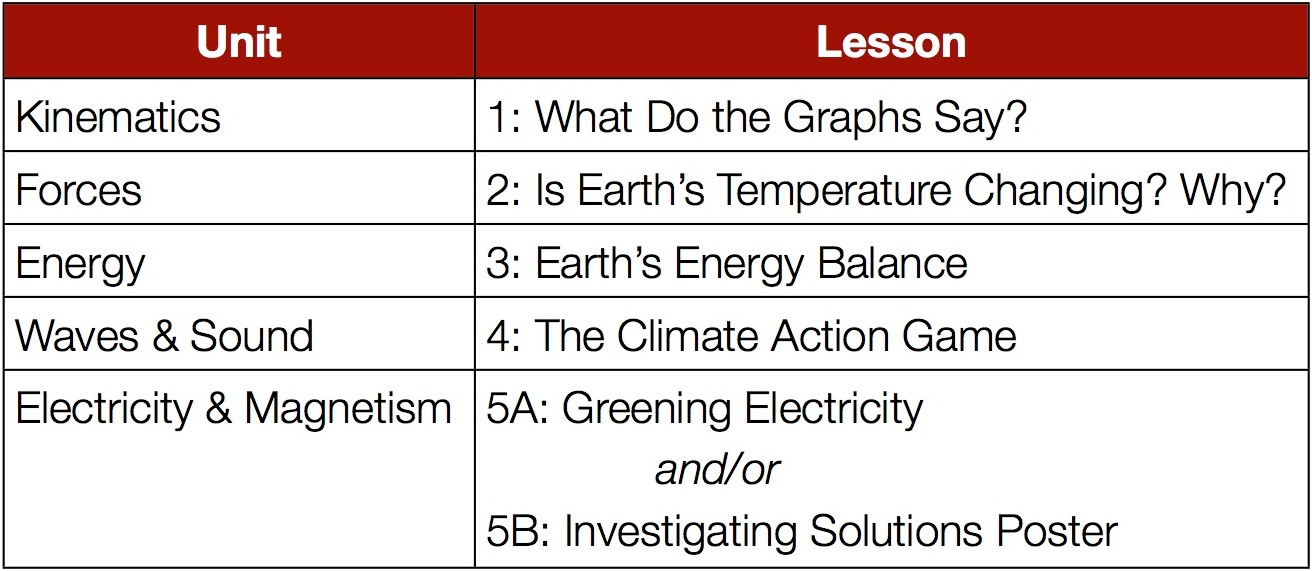September 18, 2024 Filed in:
ArticlesMichelle Lee, Lisgar C. I.
michelle.lee@ocdsb.ca
Iain Braithwaite. John F. Ross C.V.I.
iainbraithwaite@ugdsb.on.ca
Milica Rakic, Essex DHS
mica@opusteno.com
Roberta Tevlin, Retired
roberta@tevlin.ca
Climate change may be the biggest problem that humanity has ever faced. The sooner that we deal with it, the more chance we have of succeeding. Physics teachers can play an important role in helping students understand the problem and its existing solutions, and help students feel empowered to take action. This article shows how you can teach about climate change, while reinforcing fundamental skills and concepts in the grade 11 physics curriculum. As usual, these OAPT resources are free.
There are five lessons in this resource, one for each unit of the SPH3U course. The first three were introduced and tested last year and have been thoroughly reviewed and improved. They draw deeply from the
Evidence for Climate Change resource from the Perimeter Institute. Lessons 4 and 5 are completely new and are based on the excellent online resources from
Project Drawdown and
Climate Interactive.
The last two lessons deal with the solutions to climate change and are perhaps the most important lessons. Students are becoming very anxious about climate change, often feeling like it is too large a problem to combat. Knowing solutions exist and about how you can promote them is a great way to build resilience, hope and change. If you don’t have time to do anything else, make sure you do one of these.
Lessons Summary
Understanding and analyzing climate change issues involves many of the skills and topics that are covered in grade 11 physics. Here are the 5 lessons and how they connect to the course.

See below for more details about the five lessons.
Kinematics
In this unit students learn to describe motion and analyze graphs with time on the horizontal axis. In the Climate Change lesson for this unit, instead of
d-t and
v-t graphs, the students examine a series of graphs showing the CO
2 concentration vs. time over longer and longer timescales. They consider the meaning of the slope and the changing slope as well as periodic and random changes in the data.
Forces
In this unit students learn about forces, which are the causes of changing motion, which was studied in the previous unit. In the Climate Change lesson students learn about six different forcing factors that could be causing the increase in the Earth’s temperature. They see how these forcing factors add together to produce a net cause.
Energy and Society
In this unit, students learn about energy, how it is conserved, and how it changes form. In this Climate Change lesson, students use energy bar diagrams as a way to explore why the Earth is warming. They also explore how the temperature rise of the ocean and atmosphere differ because of their very different heat capacities.
Waves and Sound
There isn’t a really strong connection between the topics of this unit and Climate Change. Therefore, instead of forcing a connection, this lesson gives students a chance to play with one of the best tools for understanding the solutions to the problem: The Climate Action Game from
Climate Interactive. Students are placed in one of 6 stakeholder groups and are given the task of keeping the unnatural temperature increase to less than 2 °C. They explore the many possible solutions using a powerful computer simulation called
EN-ROADS. They learn how these different solutions interact, and which are the most effective.
Electricity and Magnetism
One of the key topics in this unit is the generation of electrical power, which also happens to be one of the largest emitters of greenhouse gases. Therefore, the Climate Change lesson focuses on how these emissions can be reduced. It makes use of the solutions detailed on the Project Drawdown website. There are two possibilities for exploring this material and you can choose to do one or both of these. One option is a lesson that has the students compare the costs and reduced emissions for 19 solutions in the electricity sector. The second option is a project where the students choose one solution and make a poster to promote it.
Notes:
- Some of these lessons are very similar to our lessons in the grade 10 Climate Change for Beginners Resource — especially the last few lessons focusing on solutions. These lessons are based on two on-line resources, Project Drawdown and EN-ROADS, which are well worth a second exploration. If you don’t teach grade 10 science, please let the science teachers in your school know about the nine lessons in our grade 10 science resource.
- We recommend that you do one of the five lessons at the end of each unit. Assure your students that the material will not be evaluated and that these lessons will provide a break before the unit test in case they need time to get caught up.
You can access both of the free climate change resources (grade 10 science and grade 11 physics) by completing this
Google Form.
Tags: Climate, Electricity, Energy, Forces, Kinematics


